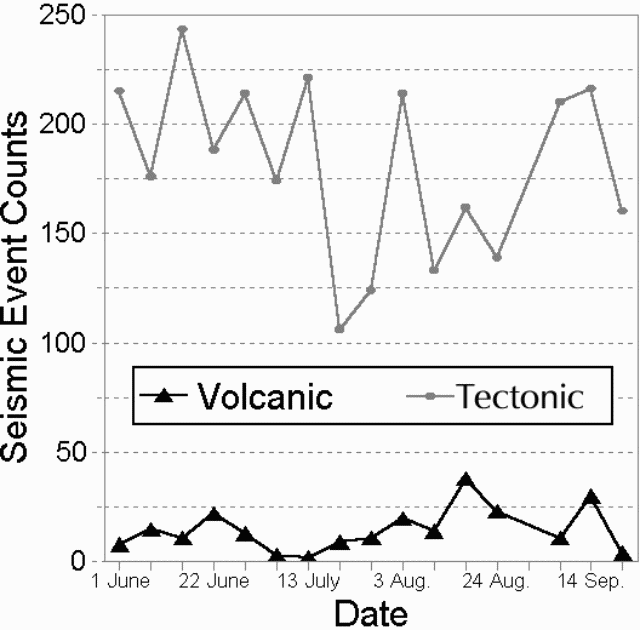Report on Karangetang (Indonesia) — August 1999
Bulletin of the Global Volcanism Network, vol. 24, no. 8 (August 1999)
Managing Editor: Richard Wunderman.
Karangetang (Indonesia) Ash emissions and crater glow continue
Please cite this report as:
Global Volcanism Program, 1999. Report on Karangetang (Indonesia) (Wunderman, R., ed.). Bulletin of the Global Volcanism Network, 24:8. Smithsonian Institution. https://doi.org/10.5479/si.GVP.BGVN199908-267020
Karangetang
Indonesia
2.781°N, 125.407°E; summit elev. 1797 m
All times are local (unless otherwise noted)
Ash emission and crater glow continued at Karangetang during the last week of May. Main Crater produced a column of thick white ash that rose 450 m above the summit. Glow was seen up to 75 m above the crater. Crater II produced a dull white column of ash 150 m in height. Tectonic events dominated the seismic record (figure 4).
 |
Figure 4. The number of volcanic and tectonic earthquakes recorded at Karangetang during June-September 1999. Data courtesy of VSI. |
This pattern of activity continued with minor changes in the height or density of ash columns at both craters and the intensity or height of glow seen at Main Crater until late in June. During early July, thick fog sometimes prevented observation of the summit. The pattern of thick ash columns rising a few hundred meters above the summit accompanied by glow up to 50 m above the summit resumed in mid-July and continued with a tendency to decreasing intensity until late September.
Geological Summary. Karangetang (Api Siau) volcano lies at the northern end of the island of Siau, about 125 km NNE of the NE-most point of Sulawesi. The stratovolcano contains five summit craters along a N-S line. It is one of Indonesia's most active volcanoes, with more than 40 eruptions recorded since 1675 and many additional small eruptions that were not documented (Neumann van Padang, 1951). Twentieth-century eruptions have included frequent explosive activity sometimes accompanied by pyroclastic flows and lahars. Lava dome growth has occurred in the summit craters; collapse of lava flow fronts have produced pyroclastic flows.
Information Contacts: Volcanological Survey of Indonesia (VSI), Jalan Diponegoro No. 57, Bandung 40122, Indonesia (URL: http://www.vsi.esdm.go.id/).

